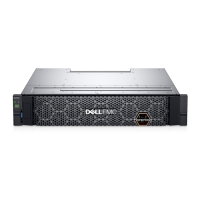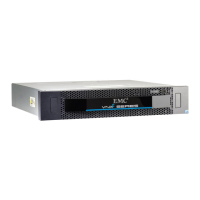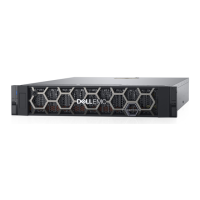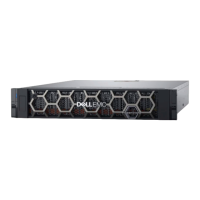Do you have a question about the Dell EMC ML3 and is the answer not in the manual?
| Number of Drives | 1 |
|---|---|
| Category | Tape Library |
| Drive Technology | LTO |
| Humidity | 20% to 80% (non-condensing) |
| Drive Type | LTO Ultrium |
| Maximum Capacity | 15 TB (compressed) |
| Interface | 6Gb/s SAS |
| Max Data Transfer Rate | up to 750 MB/s (with compression) |
| Operating Temperature | 10°C to 35°C |
| Non-operating Temperature | -40°F to 140°F (-40°C to 60°C) |
Information regarding compliance and safety standards for the library.
Specifies required firmware versions for various library features.
Provides information on how to contact Dell support for assistance.
Defines danger and caution notices and their associated symbols for safety awareness.
Details potential electrical, mechanical, and chemical hazards associated with product operation.
Outlines the steps for completing a safety inspection before servicing the unit.
Provides general safety guidelines for installing and working with rack-mounted devices.
Specifies requirements and guidelines for using power cords to prevent electrical shock.
Lists other documents and resources for additional information on the library.
Provides a general description of the Dell EMC ML3 Tape Library's capabilities and design.
Describes how the library modules are structured and the supported configurations.
Details the various physical parts and components of the tape library hardware.
Lists the LTO tape drive types implemented and qualified for use in the library.
Details key features and functionalities of the tape library.
Explains features that ensure redundant communication paths and optimize resource usage.
Details how the library generates and sends alerts and logs system events.
Provides information on compatible servers, operating systems, and adapters for library integration.
Covers requirements and settings for connecting the library to a network.
Defines requirements for space, power, and location for optimal library operation.
Recommends security measures for controlling and monitoring access to the library and its data.
Specifies criteria for choosing a suitable location for the library based on rack and power needs.
Details the physical dimensions and weight of the library modules.
Provides information on voltage, current, and power requirements for the library.
Details requirements for power cords and their proper use.
Covers the customer's responsibility for providing network connectivity and Ethernet cables.
Explains the process of selecting internal IP addresses to avoid conflicts.
Specifies requirements for host attachment, including SAS or FC HBAs and static sensitivity.
Details precautions related to product weight, personal injury, and device damage during installation.
Provides instructions for safely unpacking the library modules, including acclimation.
Step-by-step guide for installing library modules into a rack using alignment rails.
Ensures proper alignment of modules for accessor movement and library operation.
Provides instructions for connecting various types of cables to the library.
Describes the procedure for powering on the library after installation.
Guides the user through the automated initial setup wizard for library configuration.
Covers post-installation configuration tasks using the Management GUI.
Steps to confirm that the library installation is complete and functional.
Explains how to partition the library into multiple logical libraries for concurrent operations.
Describes the ability to configure multiple control paths for enhanced reliability and sharing.
Describes the configuration for a library with a single logical library.
Guidelines for configuring a library with multiple logical libraries.
Explains how SCSI element addresses are assigned to library components.
Introduces the web-based interface for monitoring, configuring, and operating the library.
Step-by-step guide for accessing the library using the Management GUI.
Details the hardware components and functionality of the library's front panel operator interface.
Provides a cross-reference table for performing management tasks via Operator Panel or Management GUI.
Lists the default parameters for user accounts and network configurations.
Explains the available methods for cleaning tape drive heads.
Details the procedures for opening and accessing cartridges within the library.
Guides the user through configuring KMIP for library-managed encryption.
Explains how to view event logs and download support tickets for troubleshooting.
Steps to identify specific hardware components that have failed within the library.
Describes the built-in tests available to verify library operations and diagnose issues.
A table listing common problems and their corresponding solutions for the tape library.
Provides information on the library's event reporting system, including codes and descriptions.
Lists warning events that may occur and provides guidance for resolution.
Explains the meaning of single-character display codes shown on tape drives for error identification.
Lists the tools required for performing upgrading and servicing procedures.
Guides users on how to identify which module contains a failed component.
Provides a diagram and description of the library's internal components.
Detailed instructions for installing and removing tape drives from the library.
Procedures for adding or replacing library modules, including safety precautions.
Instructions for safely removing and replacing the library's controller card.
Detailed steps for installing a new controller card into the library module.
Comprehensive guide for servicing the library's accessor and spooling mechanism.
Procedures for removing and replacing the library's cartridge magazines.
Guidelines and procedures for safely moving library modules within or between racks.
Forms for documenting general library settings and network configurations.
Forms for recording details about installed modules and drives.
Forms for documenting the configuration of logical libraries.
Forms for recording user account details and access levels.
Details on LTO data cartridge types, capacities, and recording formats.
Information about WORM cartridges, their features, and media errors.
Explains the purpose and usage of cleaning cartridges for drive maintenance.
Guidelines and best practices for applying bar code labels to tape cartridges.
Provides guidelines for proper handling, training, and packaging of tape cartridges.
Highlights accessibility features available in the HTML version of the document.
Explains keyboard shortcuts for navigating the help system.
Defines the component responsible for moving cartridges within the library.
Defines the Admin user role, default password, and PIN.
Defines a laser device for scanning and reading bar codes.
Defines the amount of data that can be contained on storage media.
Defines any hardware component or peripheral device that can receive and send data.
A method of storing data to protect it from inadvertent or deliberate compromise.
Defines the process or action of installing.
Tape encryption that is controlled by the tape library.
A type of tape storage technology developed by IBM, HP, and Quantum.
Web User Interface for library management and query capabilities.
The process of identifying and resolving problems with the library.
Write Once, Read Many; a method for storing data on tape with security measures.











